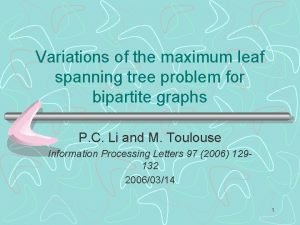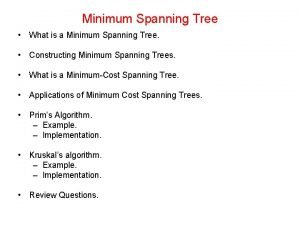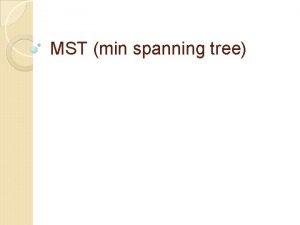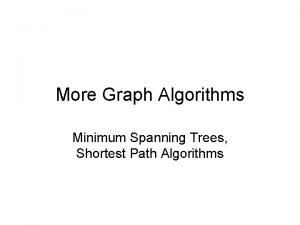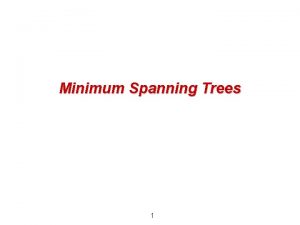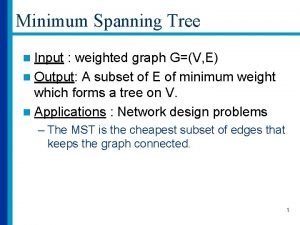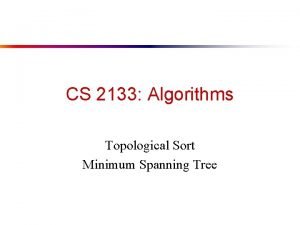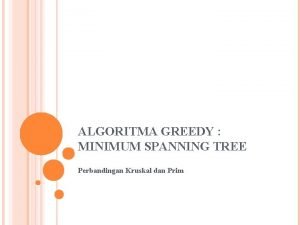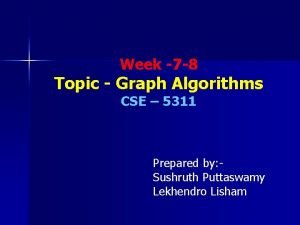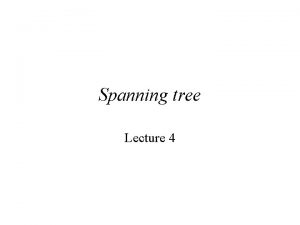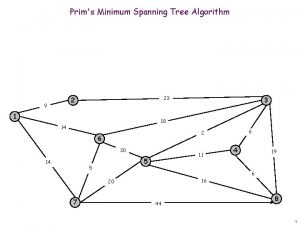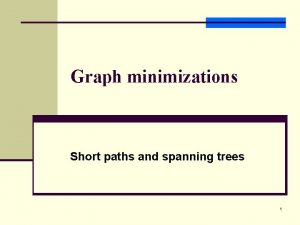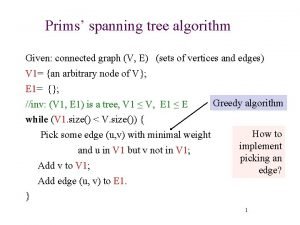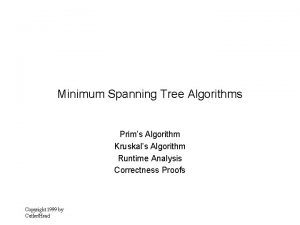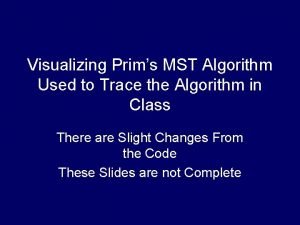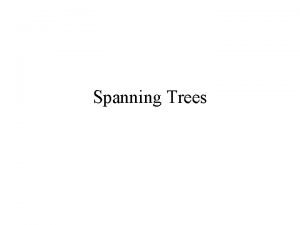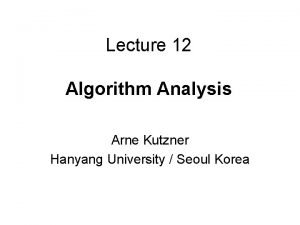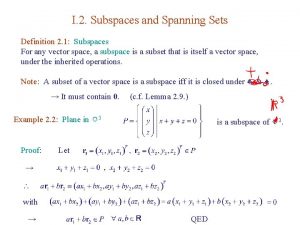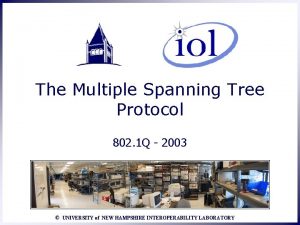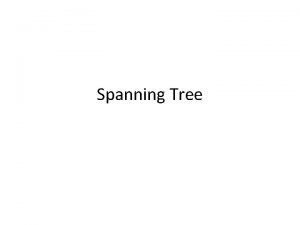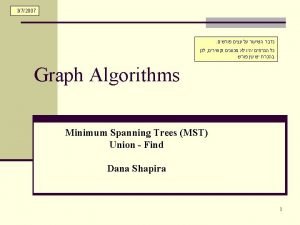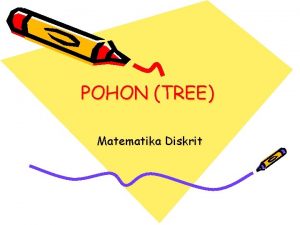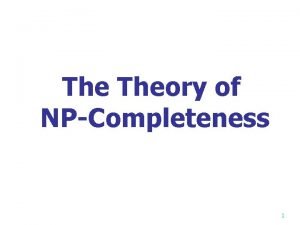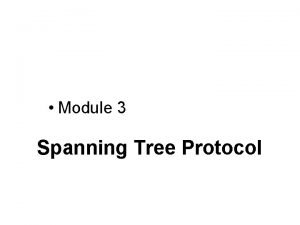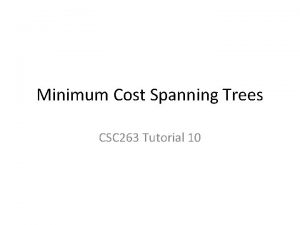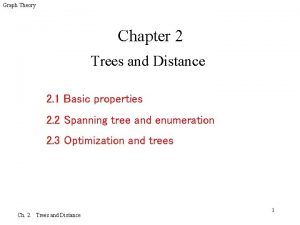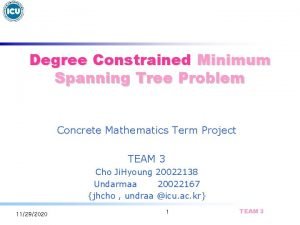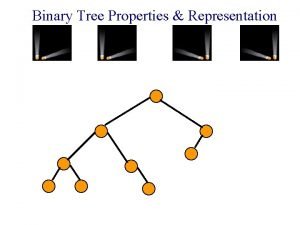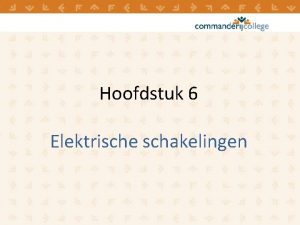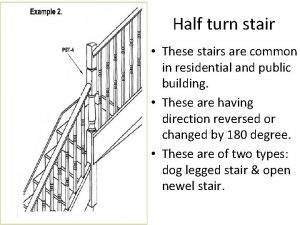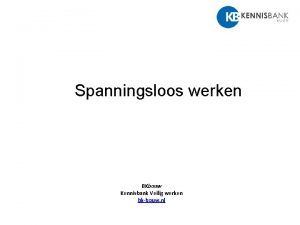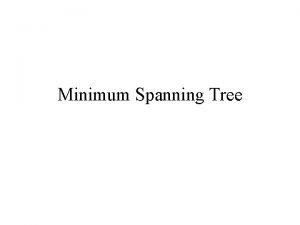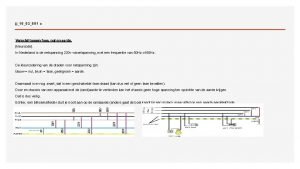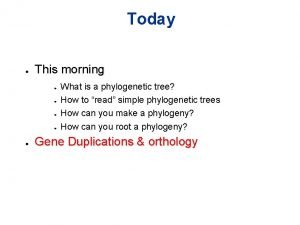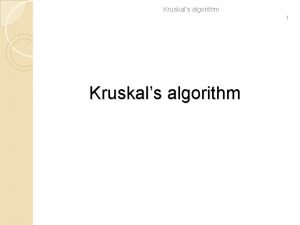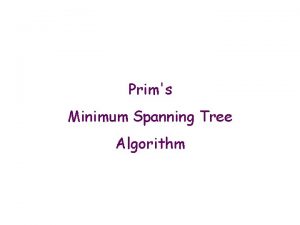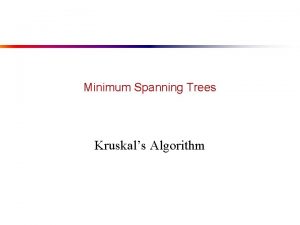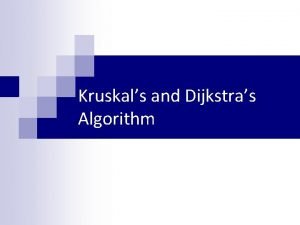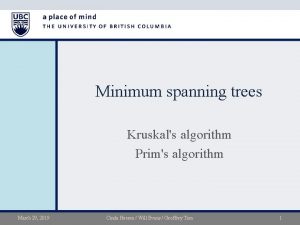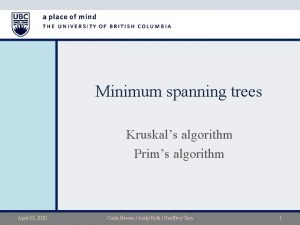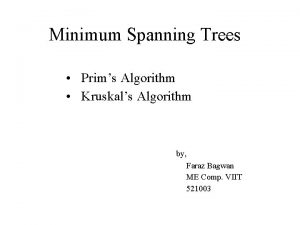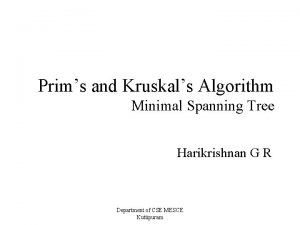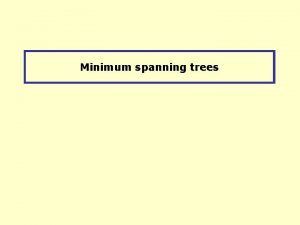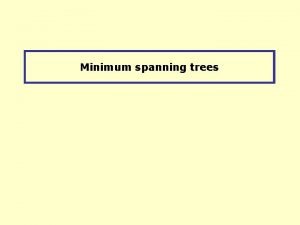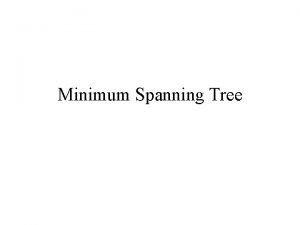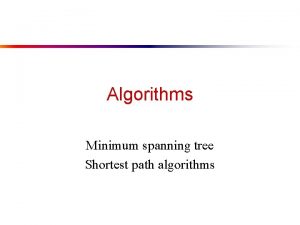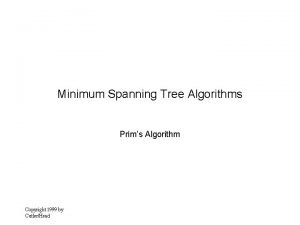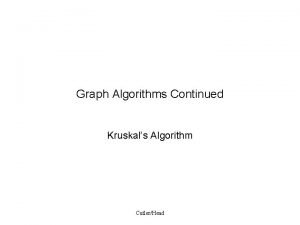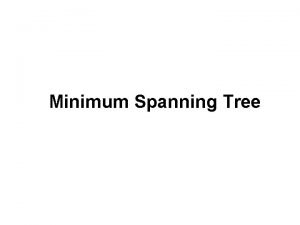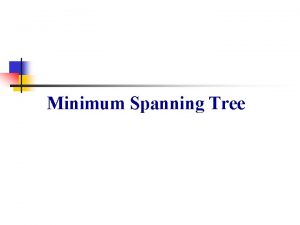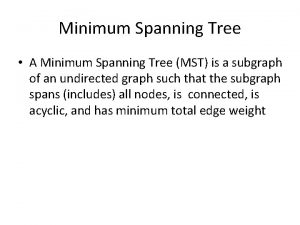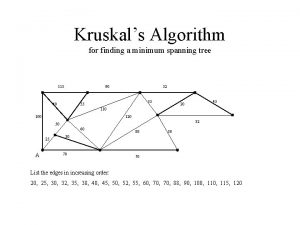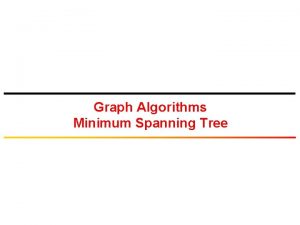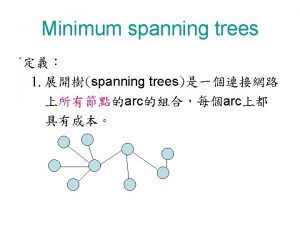Minimum Spanning Tree Algorithms Prims Algorithm Kruskals Algorithm












![Prim’s Algorithm 1. for each u V 2. do D [u ] 3. D[ Prim’s Algorithm 1. for each u V 2. do D [u ] 3. D[](https://slidetodoc.com/presentation_image_h2/4a481bad53fbf5a1c99855e2abcad2c6/image-13.jpg)



![Time Analysis 1. for each u V 2. do D [u ] 3. D[ Time Analysis 1. for each u V 2. do D [u ] 3. D[](https://slidetodoc.com/presentation_image_h2/4a481bad53fbf5a1c99855e2abcad2c6/image-17.jpg)













![Prim (G) 1. for each u V 2. do D [u ] 3. D[ Prim (G) 1. for each u V 2. do D [u ] 3. D[](https://slidetodoc.com/presentation_image_h2/4a481bad53fbf5a1c99855e2abcad2c6/image-31.jpg)

















- Slides: 48

Minimum Spanning Tree Algorithms Prim’s Algorithm Kruskal’s Algorithm Runtime Analysis Correctness Proofs Copyright 1999 by Cutler/Head

What is A Spanning Tree? • A spanning tree for an undirected graph G=(V, E) is a subgraph of G that is a tree and contains all the vertices of G a • Can a graph have more than one spanning tree? b u e • Can an unconnected graph have a spanning tree? c v f d Copyright 1999 by Cutler/Head 2

Minimal Spanning Tree. • The weight of a subgraph is the sum of the weights of it edges. • A minimum spanning tree for a weighted graph is a spanning tree with minimum weight. • Can a graph have more then one minimum spanning tree? a 4 3 b 14 v Mst T: w( T )= e 2 c 3 9 u 10 d Copyright 1999 by Cutler/Head 4 15 f 8 (u, v) T w(u, v ) is minimized 3

Example of a Problem that Translates into a MST The Problem • Several pins of an electronic circuit must be connected using the least amount of wire. Modeling the Problem • The graph is a complete, undirected graph G = ( V, E , W ), where V is the set of pins, E is the set of all possible interconnections between the pairs of pins and w(e) is the length of the wire needed to connect the pair of vertices. • Find a minimum spanning tree. Copyright 1999 by Cutler/Head 4

Greedy Choice We will show two ways to build a minimum spanning tree. • A MST can be grown from the current spanning tree by adding the nearest vertex and the edge connecting the nearest vertex to the MST. (Prim's algorithm) • A MST can be grown from a forest of spanning trees by adding the smallest edge connecting two spanning trees. (Kruskal's algorithm) Copyright 1999 by Cutler/Head 5

Notation • Tree-vertices: in the tree constructed so far • Non-tree vertices: rest of vertices Prim’s Selection rule • Select the minimum weight edge between a treenode and a non-tree node and add to the tree Copyright 1999 by Cutler/Head 6

The Prim algorithm Main Idea Select a vertex to be a tree-node while (there are non-tree vertices) { if there is no edge connecting a tree node with a non-tree node return “no spanning tree” select an edge of minimum weight between a tree node and a non-tree node 6 a 4 5 b 14 u 2 10 c v 3 d 8 15 add the selected edge and its new vertex to the tree } return tree Copyright 1999 by Cutler/Head f 7

Implementation Issues • How is the graph implemented? – Assume that we just added node u to the tree. – The distance of the nodes adjacent to u to the tree may now be decreased. – There must be fast access to all the adjacent vertices. – So using adjacency lists seems better • How should the set of non-tree vertices be represented? – The operations are: • build set • delete node closest to tree • decrease the distance of a non-tree node from the tree • check whether a node is a non- tree node Copyright 1999 by Cutler/Head 8

Implementation Issues • How should the set of non-tree vertices be represented? – A priority queue PQ may be used with the priority D[v] equal to the minimum distance of each non-tree vertex v to the tree. – Each item in PQ contains: D[v], the vertex v, and the shortest distance edge (v, u) where u is a tree node • This means: – build a PQ of non-tree nodes with initial values • fast build heap O (V ) • building an unsorted list O(V) • building a sorted list O(V) (special case) Copyright 1999 by Cutler/Head 9

Implementation Issues – delete node closest to tree (extract. Min) • O(lg V ) if heap and • O(V) if unsorted list • O(1) sorted list – decrease the distance of a non-tree node to the tree – We need to find the location i of node v in the priority queue and then execute (decrease. Priority. Value(i, p)) where p is the new priority – decrease. Priority. Value(i, p) • O(lg V) for heap, • O(1) for unsorted list • O(V ) for sorted list (too slow) Copyright 1999 by Cutler/Head 10

Implementation Issues • What is the location i of node v in a priority queue? – Find in Heaps, and sorted lists O(n) – Unsorted – if the nodes are numbered 1 to n and we use an array where node v is the v item in the array O(1) Extended heap – We will use extended heaps that contain a “handle” to the location of each node in the heap. – When a node is not in PQ the “handle” will indicate that this is the case – This means that we can access a node in the extended heap in O(1), and check v PQ in O(1) – Note that the “handle” must be updated whenever a heap operation is applied Copyright 1999 by Cutler/Head 11

Implementation Issues 2. Unsorted list – Array implementation where node v can be accesses as PQ[v] in O(1), and the value of PQ[v] indicates when the node is not in PQ. Copyright 1999 by Cutler/Head 12
![Prims Algorithm 1 for each u V 2 do D u 3 D Prim’s Algorithm 1. for each u V 2. do D [u ] 3. D[](https://slidetodoc.com/presentation_image_h2/4a481bad53fbf5a1c99855e2abcad2c6/image-13.jpg)
Prim’s Algorithm 1. for each u V 2. do D [u ] 3. D[ r ] 0 4. PQ make-heap(D, V, {})//No edges 5. T 6. 7. while PQ do 8. (u, e ) PQ. extract. Min() 9. add (u, e) to T 10. for each v Adjacent (u ) // execute relaxation 11. do if v PQ && w( u, v ) < D [ v ] 12. then D [ v ] w (u, v) 13. PQ. decrease. Priority. Value ( D[v], v, (u, v )) 14. return T // T is a mst. Copyright 1999 by Cutler/Head Lines 1 -5 initialize the priority queue PQ to contain all Vertices. Ds for all vertices except r, are set to infinity. r is the starting vertex of the T The T so far is empty Add closest vertex and edge to current T Get all adjacent vertices v of u, update D of each non-tree vertex adjacent to u Store the current minimum weight edge, and updated distance in the priority queue 13

Prim’s Algorithm Initialization Prim (G ) 1. for each u V 2. do D [u ] 3. D[ r ] 0 4. PQ make-heap(D, V, {})//No edges 5. T Copyright 1999 by Cutler/Head 14

Building the MST // solution check 7. while PQ do //Selection and feasibility 8. (u, e ) PQ. extract. Min() // T contains the solution so far. 9. add (u, e) to T 10. for each v Adjacent (u ) 11. do if v PQ && w( u, v ) < D [ v ] 12. then D [ v ] w (u, v) 13. PQ. decrease. Priority. Value (D[v], v, (u, v) ) 14. return T Copyright 1999 by Cutler/Head 15

Time Analysis Using Extended Heap implementation 1. for each u V 2. do D [u ] 3. D[ r ] 0 4. PQ make-PQ(D, V, {})//No edges 5. T 6. 7. while PQ do 8. (u, e ) PQ. extract. Min() 9. add (u, e) to T 10. for each v Adjacent (u ) 11. do if v PQ && w( u, v ) < D [ v ] 12. then D [ v ] w (u, v) 13. PQ. decrease. Priority. Value (D[v], v, (u, v)) 15. return T // T is a mst. Assume a node in PQ can be accessed in O(1) ** Decrease key for v requires O(lg. V ) provided the node in heap with v’s data can be accessed in O(1) Copyright 1999 by Cutler/Head Lines 1 -6 run in O (V ) Max Size of PQ is | V | Count 7 =O (V ) Count 7(8) = O (V ) O( lg V ) Count 7(10) = O( deg(u ) ) = O( E ) Count 7(10(11)) = O(1) O( E ) Count 7(10(11(12))) = O(1) O( E ) Count 7(10(13)) = O( lg V) O( E ) Decrease. Key operation on the extended heap can be implemented in O( lg V) So total time for Prim's Algorithm is O ( V lg V + E lg V ) What is O(E ) ? Sparse Graph, E =O(V) , O (E lg V)=O(V lg V ) Dense Graph, E=O(V 2), O (E lg V)=O(V 2 lg V) 16
![Time Analysis 1 for each u V 2 do D u 3 D Time Analysis 1. for each u V 2. do D [u ] 3. D[](https://slidetodoc.com/presentation_image_h2/4a481bad53fbf5a1c99855e2abcad2c6/image-17.jpg)
Time Analysis 1. for each u V 2. do D [u ] 3. D[ r ] 0 4. PQ make-PQ(D, V, {})//No edges 5. T 6. 7. while PQ do 8. (u, e ) PQ. extract. Min() 9. add (u, e) to T 10. for each v Adjacent (u ) 11. do if v PQ && w( u, v ) < D [ v ] 12. then D [ v ] w (u, v) 13. PQ. decrease. Priority. Value (D[v], v, (u, v)) 15. return T // T is a mst. Using unsorted PQ Lines 1 - 6 run in O (V ) Max Size of PQ is | V | Count 7 = O (V ) Count 7(8) = O (V ) O(V ) Count 7(10) = O( deg(u ) ) = O( E ) Count 7(10(11)) = O(1) O( E ) Count 7(10(11(12))) = O(1) O( E ) Count 7(10(13)) =O( 1) O( E ) So total time for Prim's Algorithm is O (V + V 2 + E ) = O (V 2 ) For Sparse/Dense graph : O( V 2 ) Note growth rate unchanged for adjacency matrix graph representation Copyright 1999 by Cutler/Head 17

Prim - extended Heap After Initialization handle A 1 2 6 B B 2 5 C 3 A C T 1 PQ 0, (A, {}) G Prim (G, r) 1. for each u V 2. do D [u ] 3. D[ r ] 0 4. PQ make-heap(D, V, { }) 5. T Copyright 1999 by Cutler/Head 2 , (B, {}) 3 , (C, {}) G A B C B 2 C 6 A 2 C 5 A 6 B 5 18

Prim - extended Heap Build tree - after PQ. extract. Min A 2 6 C 5 B handle A Null B 2 C 1 T (A, {}) PQ 1 , (C, {}) G 7. while PQ do 8. (u, e) PQ. extract. Min() 9. add (u, e) to T Copyright 1999 by Cutler/Head 2 , (B, {}) 19

Update B adjacent to A A 2 6 C 5 B handle A Null B 1 C 2 T (A, {}) PQ 1 2, (B, {A, B}) G 10. 11. for each v Adjacent (u ) // relaxation operation Copyright 1999 by Cutler/Head 2 , (C, {}) // relaxation 11. do if v PQ && w( u, v ) < D [ v ] 12. then D [ v ] w (u, v) 13. PQ. decrease. Priority. Value ( D[v], v, (u, v)) 20

Update C adjacent to A handle A Null B 1 C 2 A C 5 PQ 1 2, (B, {A, B}) 2 6, (C, {A, C}) 2 6 T (A, {}) B G Copyright 1999 by Cutler/Head 21

Build tree - after PQ. extract. Min handle A Null B Null C 1 A 2 6 C 5 B T (A, {}) (B, {A, B}) PQ 1 6, (C, {A, C}) 7. while PQ do 8. (u, e) PQ. extract. Min() 9. add (u, e) to T G Copyright 1999 by Cutler/Head 22

Update C adjacent to B handle A Null B Null C 1 A 10. 11. 2 6 C 5 T (A, {}) (B, {A, B}) PQ 1 5, (C, {B, C}) for each v Adjacent (u ) // relaxation operation B G Copyright 1999 by Cutler/Head 23

Build tree - after PQ. extract. Min handle A Null B Null C Null A 2 6 C 5 B T (A, {}) (B, {A, B}) (C, {B, C}) PQ 7. while PQ do 8. (u, e) PQ. extract. Min() 9. add (u, e) to T G Copyright 1999 by Cutler/Head 24

Prim - unsorted list After Initialization A 4 5 PQ T 12 B B A C 0, (A, {}) , (B, {}) , (C, {}) C G Prim (G, r) 1. for each u V 2. do D [u ] 3. D[ r ] 0 4. PQ make-PQ(D, V, { }) 5. T Copyright 1999 by Cutler/Head G A B C B 12 C 4 A 12 C 5 A 4 B 5 25

Build tree - after PQ. extract. Min A 4 5 12 B T (A, {}) PQ A B C Null , (B, {}) , (C, {}) C G 7. while PQ do 8. (u, e) PQ. extract. Min() 9. add (u, e) to T Copyright 1999 by Cutler/Head 26

Update B, C adjacent to A A 4 5 12 B PQ T (A, {}) A B C Null 12, (B, {A, B}) 4, (C, {A, C}) C G 10. 11. Copyright 1999 by Cutler/Head for each v Adjacent (u ) // relaxation operation 27

Build tree - after PQ. extract. Min A 4 5 12 B T (A, {}) (C, {A, C}) C G PQ A B C Null 12, (B, {A, B}) Null 7. while PQ do 8. (u, e) PQ. extract. Min() 9. add (u, e) to T Copyright 1999 by Cutler/Head 28

Update B adjacent to C A 4 5 12 B A C B C Null 5, (B, {C, B}) Null G 10. 11. Copyright 1999 by Cutler/Head PQ T (A, {}) (C, {A, C}) for each v Adjacent (u ) // relaxation operation 29

Build tree - after PQ. extract. Min A 4 5 12 B T (A, {}) (C, {A, C}) (B, {C, B}) C G PQ A B C Null 7. while PQ do 8. (u, e) PQ. extract. Min() 9. add (u, e) to T Copyright 1999 by Cutler/Head 30
![Prim G 1 for each u V 2 do D u 3 D Prim (G) 1. for each u V 2. do D [u ] 3. D[](https://slidetodoc.com/presentation_image_h2/4a481bad53fbf5a1c99855e2abcad2c6/image-31.jpg)
Prim (G) 1. for each u V 2. do D [u ] 3. D[ r ] 0 4. PQ make-heap(D, V, { }) 5. T G= D = [ 0, a 14 g 2 f Copyright 1999 by Cutler/Head 9 e c d ] T={} 10 3 4 5 b …, PQ = {( 0, (a, )), ( , (b, ? )), . . . ( , (h, ? ))} r 6 , 15 h 8 31

// relaxation 11. do if v PQ && w( u, v ) < D [ v ] 12. then D [ v ] w (u, v) 13. PQ. decrease. Priority. Value ( D[v], v, (u, v)) 7. while PQ do 8. (u, e) PQ. extract. Min() 9. add (u, e) to T 10. for each v Adjacent (u ) 11. // relaxation operation 15. return T D = [ 0, G= r 6 a 5 b 14 f Copyright 1999 by Cutler/Head g PQ = { 2 c d 9 e 10 3 T={ 4 15 h 8 32

Lemma 1 Let G = ( V, E) be a connected, weighted undirected graph. Let T be a promising subset of E. Let Y be the set of vertices connected by the edges in T. If e is a minimum weight edge that connects a vertex in Y to a vertex in V - Y, then T { e } is promising. Note: A feasible set is promising if it can be extended to produce not only a solution , but an optimal solution. In this algorithm: A feasible set of edges is promising if it is a subset of a Minimum Spanning Tree for the connected graph. Copyright 1999 by Cutler/Head 33

Outline of Proof of Correctness of Lemma 1 T is the promising subset, and e the minimum cost edge of Lemma 1 Let T ' be the MST such that T T ' We will show that if e T' then there must be another MST T" such that T {e} T". Proof has 4 stages: 1. Adding e to T', closes a cycle in T' {e}. 2. Cycle contains another edge e' T' but e' T 3. T"=T' {e} - {e’ } is a spanning tree 4. T" is a MST Copyright 1999 by Cutler/Head 34

Lemma 1 The Promising Set of Edges Selected by Prim Y X V -Y T X X e X X X MST T' but e T' X X X Copyright 1999 by Cutler/Head X X 35

Lemma 1 Since T' is a spanning tree, it is connected. Adding the edge, e, creates a cycle. Y X T' {e} X u X V -Y e X X v Stage 1 X X X In T' there is a path from u Y to v V -Y. Therefore the path must include another edge e' with one vertex in Y and the other in V-Y. X X X Stage 2 X X Copyright 1999 by Cutler/Head e' X X 36

Lemma 1 • If we remove e’ from T’ { e } the cycle disappears. • T”=T’ { e } - {e’} is connected. T’ is connected. Every pair of vertices connected by a path that does not include e’ is still connected in T”. Every pair of vertices connected by a path that included e’ , is still connected in T” because there is a path in T" =T’ { e } - { e’ } connecting the vertices of e’. X T" X e Y X V -Y Stage 3 X X X w( e ) w( e' ) By the way Prim picks the next edge Copyright 1999 by Cutler/Head 37

Lemma 1 • • w( e ) w( e' ) by the way Prim picks the next edge. The weight of T", w(T") = w (T' ) + w( e ) - w( e' ) w(T'). But w (T' ) w(T") because T' is a MST. So w (T' ) = w(T") and T" is a MST X T" X e Y X V -Y Stage 4 X X X Conclusion T { e } is promising Copyright 1999 by Cutler/Head 38

Theorem : Prim's Algorithm always produces a minimum spanning tree. Proof by induction on the set T of promising edges. Base case: Initially, T = is promising. Induction hypothesis: The current set of edges T selected by Prim is promising. Induction step: After Prim adds the edge e, T { e } is promising. Proof: T { e } is promising by Lemma 1. Conclusion: When G is connected, Prim terminates with |T | = |V | -1, and T is a MST. Copyright 1999 by Cutler/Head 39

Kruskal’s Algorithm Copyright 1999 by Cutler/Head

Kruskal's Algorithm: Main Idea solution = { } while ( more edges in E) do // Selection select minimum weight edge remove edge from E // Feasibility 6 a 4 5 b 14 u 2 10 c 3 if (edge closes a cycle with solution so far) then reject edge else add edge to solution d v 8 15 f // Solution check if |solution| = |V | - 1 return solution return null // when does this happen? Copyright 1999 by Cutler/Head 41

Kruskal's Algorithm: 1. Sort the edges E in non-decreasing weight 2. T 6 3. For each v V create a set. 4. repeat b 5. Select next {u, v} E, in order 6. ucomp find (u) 14 7. vcomp find (v) c 8. if ucomp vcomp then 8. add edge (u, v) to T 3 9. union ( ucomp, vcomp ) 10. until T contains |V | - 1 edges 11. return tree T a 4 5 e g 2 10 f d 9 15 h 8 C = { {a}, {b}, {c}, {d}, {e}, {f}, {g}, {h} } C is a forest of trees. Copyright 1999 by Cutler/Head 42

Kruskal - Disjoint set After Initialization A Sorted edges 2 6 C AB 2 B B C 5 5 G T AC 6 7 D 1. Sort the edges E in non-decreasing weight 2. T BD 7 D A B C Disjoint data set for G 3. For each v V create a set. Copyright 1999 by Cutler/Head 43

Kruskal - add minimum weight edge if feasible A Sorted edges 2 6 C 5 G T AB 2 (A, B) B C 5 B 7 AC 6 D 5. for each {u, v} in ordered E 6. ucomp find (u) 7. vcomp find (v) 8. if ucomp vcomp then 9. add edge (v, u) to T 10. union( ucomp, vcomp ) Copyright 1999 by Cutler/Head BD 7 Find(A) A Find(B) B C Disjoint data set for G A C D D B After merge(A, B) 44

Kruskal - add minimum weight edge if feasible A Sorted edges 2 6 C 5 G T AB 2 (A, B) B C 5 B 7 (B, C) AC 6 D 5. for each {u, v} in ordered E 6. ucomp find (u) 7. vcomp find (v) 8. if ucomp vcomp then 9. add edge (v, u) to T 10. union ( ucomp, vcomp ) BD 7 Find(B) Find(C) A C B A After merge(A, C) B Copyright 1999 by Cutler/Head D C D 45

Kruskal - add minimum weight edge if feasible A Sorted edges 2 6 C 5 G T AB 2 (A, B) B C 5 B 7 (B, C) AC 6 D 5. for each {u, v} in ordered E 6. ucomp find (u) 7. vcomp find (v) 8. if ucomp vcomp then 9. add edge (v, u) to T 10. union ( ucomp, vcomp ) Copyright 1999 by Cutler/Head BD 7 Find(A) Find(C) A D B C A and C in same set 46

Kruskal - add minimum weight edge if feasible A Sorted edges 2 6 C 5 G T AB 2 (A, B) B C 5 B 7 (B, C) AC 6 D 5. for each {u, v} in ordered E 6. ucomp find (u) 7. vcomp find (v) 8. if ucomp vcomp then 9. add edge (v, u) to T 10. union ( ucomp, vcomp ) Copyright 1999 by Cutler/Head (B, D) BD 7 Find(B) Find(D) A D B C A After merge B C D 47

Kruskal's Algorithm: Time Analysis Kruskal ( G ) 1. Sort the edges E in non-decreasing weight 2. T 3. For each v V create a set. 4. repeat 5. {u, v} E, in order 6. ucomp find (u) 7. vcomp find (v) 8. if ucomp vcomp then 9. add edge (v, u) to T 10. union ( ucomp, vcomp ) 11. until T contains |V | - 1 edges 12. return tree T Copyright 1999 by Cutler/Head Count 1 = ( E lg E ) Count 2= (1) Count 3= ( V ) Count 4 = O( E ) Using Disjoint set-height and path compression Count 4(6+7+10)= O((E +V) (V)) Sorting dominates the runtime. We get T( E, V ) = ( E lg E), so for a sparse graph we get ( V lg V) for a dense graph we get ( V 2 lg V 2) = ( V 2 lg V) 48
 Minimum leaf spanning tree
Minimum leaf spanning tree Minimum cost spanning tree
Minimum cost spanning tree Dijkstra tree
Dijkstra tree Dijkstra's algorithm proof
Dijkstra's algorithm proof Minimum spanning tree definition
Minimum spanning tree definition Minimum spanning tree shortest path
Minimum spanning tree shortest path Minimum spanning tree
Minimum spanning tree Minimum spanning tree weighted graph
Minimum spanning tree weighted graph Minimum spanning tree
Minimum spanning tree Algoritma kruskal
Algoritma kruskal Minimum spanning tree
Minimum spanning tree Minimum spanning tree
Minimum spanning tree Minimum spanning tree
Minimum spanning tree Minimum spanning tree
Minimum spanning tree Difference between prims and kruskal
Difference between prims and kruskal Prims algorithm runtime
Prims algorithm runtime Prims algorithm visualization
Prims algorithm visualization Prim's algorithm time complexity
Prim's algorithm time complexity Prim pseudocode
Prim pseudocode Spanning tree algorithm in computer networks
Spanning tree algorithm in computer networks Subspaces and spanning sets
Subspaces and spanning sets Common spanning tree
Common spanning tree Spanning tree definition
Spanning tree definition Spanning tree
Spanning tree Contoh soal pohon ekspresi matematika diskrit
Contoh soal pohon ekspresi matematika diskrit Brily
Brily Udld normal vs aggressive
Udld normal vs aggressive Pohon ekspresi
Pohon ekspresi Spanning tree of a graph
Spanning tree of a graph Spanning tree of a graph
Spanning tree of a graph Petr lapukhov
Petr lapukhov Bpdu
Bpdu Csc longin
Csc longin What is a subgraph in graph theory
What is a subgraph in graph theory Degree constrained spanning tree
Degree constrained spanning tree Asus spanning tree protocol
Asus spanning tree protocol Local maximum and minimum vs. absolute maximum and minimum
Local maximum and minimum vs. absolute maximum and minimum Minimum number of nodes in full binary tree
Minimum number of nodes in full binary tree Veilige spanning besloten ruimte
Veilige spanning besloten ruimte Atoomkern
Atoomkern Half turn stair
Half turn stair Werken onder spanning nen 3140
Werken onder spanning nen 3140 Vlan spanning
Vlan spanning Boundary spanning leadership definition
Boundary spanning leadership definition Atoom
Atoom Spanning trees
Spanning trees Boundary spanning adalah
Boundary spanning adalah Spanning tussen fase en aarde
Spanning tussen fase en aarde Species tree
Species tree
